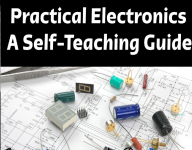Practical Electronics A Self-Teaching Guide

Password:
SUBSCRIBE TO OUR CHANNEL WE WILL PUBLISH LAPTOP REPAIR COURSE IN THIS CHANNEL FOR FREE.
WE NEED MORE SUBSCRIBERS THEN ONLY WE WILL PUBLISH SOON
For Laptop component level repair course videos free visit our YouTube channel
_*_*_*_*_*_*_*_*_*_*_*_*_*_*_*_*_*_*_*_*_*_*_*_*_*_*_*_*_*_*_*_*_*_*_*_*_*_*_*_*_*_*_*_*_*_*_*_*_*_*_*_*_*_*_*_*_*_*_*_*_*_*_*__*_*_*_*_*_*_*_*_*_*_*_*_*_*_*__*_*_*_*_*_*_*_*_*__*_*_*_
1. Resistors, Capacitors, and Voltage
This chapter introduces the fundamental components of electronic circuits: resistors, capacitors, and voltage. It explains their functions, how they interact in a circuit, and provides practical examples and exercises to reinforce understanding.
2. Inductors, Transformers, and Resonance
This chapter delves into inductors and transformers, explaining their principles and uses in circuits. It also covers the concept of resonance, an important phenomenon in AC circuits, and provides practical exercises to illustrate these concepts.
3. Introduction to Semiconductors
This chapter introduces the basic concepts of semiconductors, the building blocks of modern electronics. It covers the properties of semiconductor materials, the function of diodes, and the basics of transistor operation.
4. More Semiconductor Circuits
Building on the previous chapter, this section explores more complex semiconductor circuits. It includes detailed discussions on various types of transistors, their applications in amplifiers and switches, and practical circuit examples.
5. Feedback and IC Amplifiers
This chapter focuses on feedback mechanisms in electronic circuits and the use of integrated circuit (IC) amplifiers. It explains the principles of feedback, different types of amplifiers, and their practical applications in electronic design.
6. IC Applications
This chapter covers a wide range of applications for integrated circuits. It provides examples of how ICs are used in various electronic devices and systems, and includes practical projects to demonstrate their versatility.
7. Circuit Construction, Radiation, and Interference
This chapter addresses the practical aspects of circuit construction, including techniques for building and testing circuits. It also discusses issues related to electromagnetic radiation and interference, and how to mitigate these problems in electronic design.
8. A Review of Basic Electrical Concepts
This chapter reviews the fundamental electrical concepts covered earlier in the book. It serves as a refresher to ensure that readers have a solid grasp of the basic principles before moving on to more advanced topics.
Appendix I: Preparing to Use the Learning Circuits
This appendix provides additional information and preparatory steps for using the learning circuits discussed in the book. It includes safety tips, necessary tools, and preliminary exercises to get readers ready for hands-on experimentation.
Appendix II: Basic Algebra
This appendix covers the basic algebraic concepts and techniques needed to understand and solve electronic circuit problems. It serves as a mathematical primer for readers who may need a refresher or additional support with algebra.

Password:
SUBSCRIBE TO OUR CHANNEL WE WILL PUBLISH LAPTOP REPAIR COURSE IN THIS CHANNEL FOR FREE.
WE NEED MORE SUBSCRIBERS THEN ONLY WE WILL PUBLISH SOON
For Laptop component level repair course videos free visit our YouTube channel
_*_*_*_*_*_*_*_*_*_*_*_*_*_*_*_*_*_*_*_*_*_*_*_*_*_*_*_*_*_*_*_*_*_*_*_*_*_*_*_*_*_*_*_*_*_*_*_*_*_*_*_*_*_*_*_*_*_*_*_*_*_*_*__*_*_*_*_*_*_*_*_*_*_*_*_*_*_*__*_*_*_*_*_*_*_*_*__*_*_*_
1. Resistors, Capacitors, and Voltage
This chapter introduces the fundamental components of electronic circuits: resistors, capacitors, and voltage. It explains their functions, how they interact in a circuit, and provides practical examples and exercises to reinforce understanding.
2. Inductors, Transformers, and Resonance
This chapter delves into inductors and transformers, explaining their principles and uses in circuits. It also covers the concept of resonance, an important phenomenon in AC circuits, and provides practical exercises to illustrate these concepts.
3. Introduction to Semiconductors
This chapter introduces the basic concepts of semiconductors, the building blocks of modern electronics. It covers the properties of semiconductor materials, the function of diodes, and the basics of transistor operation.
4. More Semiconductor Circuits
Building on the previous chapter, this section explores more complex semiconductor circuits. It includes detailed discussions on various types of transistors, their applications in amplifiers and switches, and practical circuit examples.
5. Feedback and IC Amplifiers
This chapter focuses on feedback mechanisms in electronic circuits and the use of integrated circuit (IC) amplifiers. It explains the principles of feedback, different types of amplifiers, and their practical applications in electronic design.
6. IC Applications
This chapter covers a wide range of applications for integrated circuits. It provides examples of how ICs are used in various electronic devices and systems, and includes practical projects to demonstrate their versatility.
7. Circuit Construction, Radiation, and Interference
This chapter addresses the practical aspects of circuit construction, including techniques for building and testing circuits. It also discusses issues related to electromagnetic radiation and interference, and how to mitigate these problems in electronic design.
8. A Review of Basic Electrical Concepts
This chapter reviews the fundamental electrical concepts covered earlier in the book. It serves as a refresher to ensure that readers have a solid grasp of the basic principles before moving on to more advanced topics.
Appendix I: Preparing to Use the Learning Circuits
This appendix provides additional information and preparatory steps for using the learning circuits discussed in the book. It includes safety tips, necessary tools, and preliminary exercises to get readers ready for hands-on experimentation.
Appendix II: Basic Algebra
This appendix covers the basic algebraic concepts and techniques needed to understand and solve electronic circuit problems. It serves as a mathematical primer for readers who may need a refresher or additional support with algebra.
